

Energy efficiency labels are informational labels on the appliances or its packaging. Certified by countries or regions, energy efficiency labels provide the information of energy consumption, energy efficiency level and other performance indicators of household appliances, which allows you to choose appliances on the basis of their energy efficiency and helps you to be a savvy customer. Energy-efficient appliances can save families about a third on their energy bill.
At present, the energy efficiency labelling scheme has not been implemented in Macau, but citizens can refer to the energy efficiency labels on the imported appliances, the major imported countries/regions include Mainland China, Hong Kong and European Union. The grading displayed on the labels indicate the energy efficiency of the appliances, with Grade 1 (A) the most efficient, Grade 2 (B) the second most efficient and so on. Three common types of energy efficiency labels are listed as follows:
The energy efficiency labelling scheme is divided into “Voluntary” and “Mandatory”. Mandatory Energy Efficiency Labelling Scheme (MEELS) requires energy labels to be shown on the prescribed products supplying in Hong Kong, currently covering five types of prescribed products, namely air conditioners, refrigerating appliances, compact fluorescent lamps (CFLs), washing machines and dehumidifiers.
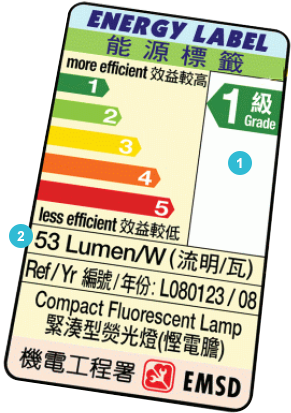 | Grade 1 products are most efficient (green) and have an average lamp life of 8,000 hours or above. Grade 5 products have an average lamp life of below 6,000 hours (red). |
| Lamp luminous efficacy of the model. A higher number indicates that the product is more efficient. |
Voluntary Energy Efficiency Labelling Scheme (VEELS) aims to encourage suppliers to take energy saving and energy efficiency into account when producing electrical appliances. The Scheme covers 22 types of household appliances, including room air conditioners (cooling capacity within 7.5-10 kW), household refrigeration appliances, washing machines (washing capacity within 7-10 kg), electric clothes dryers, electric storage water heaters, televisions, dehumidifiers (dehumidifying capacity within 35-87 L per day), electric rice-cookers, induction cookers and LED lamps, etc. The 7 types of office equipment include photocopiers, fax machines, multifunction devices, printers, LCD monitors, computers and hot/cold bottled water dispensers. Household electric appliances and office equipment are operated in two types of energy labelling system, namely, “Grading Type” and “Recognition Type”.
 | According to the 5 energy efficiency grades: • Grade 1 is the most energy efficient |
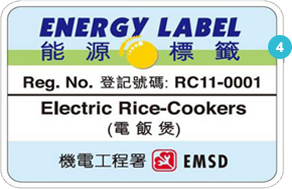 | “Recognition Type” Energy Label indicates the product meets the minimum energy efficiency and performance requirements |
In addition, the Scheme has extended to cover petrol passenger cars, in which the fuel consumption between vehicles is compared through a standard test. The “Comparison Type” Energy Label is utilized.
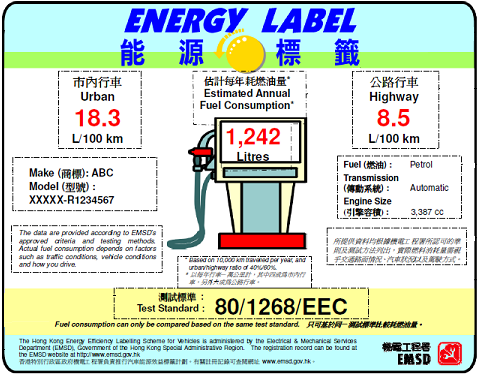
The energy efficiency labelling scheme is divided into “Voluntary” and “Mandatory”. Mandatory Energy Efficiency Labelling Scheme (MEELS) requires energy labels to be shown on the prescribed products supplying in Hong Kong, currently covering five types of prescribed products, namely air conditioners, refrigerating appliances, compact fluorescent lamps (CFLs), washing machines and dehumidifiers.
 | Grade 1 products are most efficient (green) and have an average lamp life of 8,000 hours or above. Grade 5 products have an average lamp life of below 6,000 hours (red). |
| Lamp luminous efficacy of the model. A higher number indicates that the product is more efficient. |
Voluntary Energy Efficiency Labelling Scheme (VEELS) aims to encourage suppliers to take energy saving and energy efficiency into account when producing electrical appliances. The Scheme covers 22 types of household appliances, including room air conditioners (cooling capacity within 7.5-10 kW), household refrigeration appliances, washing machines (washing capacity within 7-10 kg), electric clothes dryers, electric storage water heaters, televisions, dehumidifiers (dehumidifying capacity within 35-87 L per day), electric rice-cookers, induction cookers and LED lamps, etc. The 7 types of office equipment include photocopiers, fax machines, multifunction devices, printers, LCD monitors, computers and hot/cold bottled water dispensers. Household electric appliances and office equipment are operated in two types of energy labelling system, namely, “Grading Type” and “Recognition Type”.
 | According to the 5 energy efficiency grades: • Grade 1 is the most energy efficient |
 | “Recognition Type” Energy Label indicates the product meets the minimum energy efficiency and performance requirements |
In addition, the Scheme has extended to cover petrol passenger cars, in which the fuel consumption between vehicles is compared through a standard test. The “Comparison Type” Energy Label is utilized.

Mainland China is currently implementing a mandatory energy efficiency labelling system, targeting 15 types of products in four groups, which Grade 1 the most energy efficient and grade 5 the least.
Group 1: room air-conditioners, household refrigerators
Group 2: washing machines, unitary air-conditioners
Group 3: CFLs, High Pressure Sodium lamps (HPS), small and medium three-phase asynchronous motors, water chiller units, household instantaneous gas water heater and gas-fired heating and hot water combi-boiler
Group 4: variable speed room air-conditioners, multi-connected air-conditioning (heat pump) units, storage electric water heaters, household induction cookers, computer monitors, photocopiers
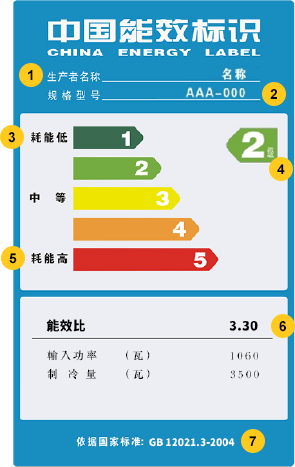 | Responsible party, brand owner |
| Product model | |
| High energy efficiency, low energy consumption | |
| Main content of the label, determined by energy efficiency standard | |
| Low energy efficiency, high energy consumption | |
| The energy consumption and main performance indexes of different products are different, which are defined based on the technical requirements specified in the energy label. | |
| Valid edition of current energy efficiency standard |
EU’s energy labelling rating is from A to G, with A or A+++ the most energy efficient and G the least.
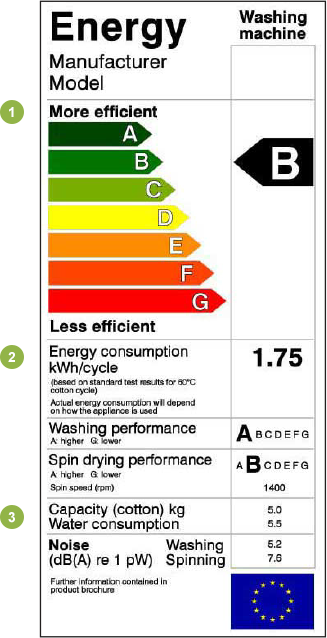 | Energy efficiency rating A (or A++ for fridges and freezers) is the most efficient, and G is the least efficient, based on the product’s energy consumption. |
| Energy consumption The energy efficiency rating for each product is calculated using specific EU-defined criteria. Here, for washing machines, the rating is calculated by measuring the kilowatt hours used during a 60°C cotton cycle for a typical 6kg load. | |
| Product-specific information You’ll also find extra data related to the product, such as capacity, water consumption and noise levels. |
As the design and grading criteria of energy labels vary in different countries/regions, energy labels could not be compared directly. For instance, an air-conditioner with Hong Kong Energy Efficiency Label Grade 1 is equivalent to Grade 3 in Mainland China and Grade B in EU. Citizens should be aware of the actual performance indicators specified in the labels when purchasing energy efficient appliances.
 Login
Login